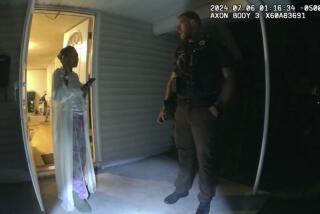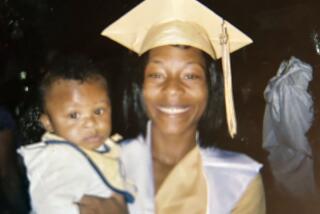From the Archives: Federal marshal’s description of fatal shooting conflicts with video footage
Matthew Itkowitz, an off-duty deputy U.S. marshal, was being beaten and threatened with a gun in an alley off Melrose Avenue when, in fear for his life, he managed to draw his own weapon and fatally shoot his attacker.
At least, that’s the story Itkowitz told Los Angeles police.
What really happened that night in the Fairfax district is less clear-cut. Witnesses’ accounts of what happened before the shooting vary. But footage from a surveillance camera, which has never been made public, calls into question the deputy marshal’s claim of self-defense. A copy of the tape was reviewed by The Times.
The footage of the March 5, 2008, encounter, coupled with other evidence from the scene, raises a disturbing possibility: that a drunk cop fatally shot a man in the back to settle a score.
Whether prosecutors see it that way is another matter.
***
After knocking back shots of tequila at a Mexican restaurant a few blocks from their apartment, Itkowitz and his wife, Alexandra, began to argue as they walked home. The couple, both in their 30s, were having problems in their marriage and were discussing a separation.
Itkowitz became angry, his wife would later tell police. She said her husband pushed her and took a baseball cap from her head and swatted her. She was crying as she followed him down an alley they used as a shortcut home.
One witness told police she heard Itkowitz tell his wife: “You’re out. You’re gone. We’re done.”
Still crying, his wife responded, “You’re drunk.”
Itkowitz turned and walked quickly back toward her. Frightened, she ran to a group of people standing near the rear entrance to a tattoo parlor and asked for help. One of them was Ryan Gonzalez, the manager of the shop, who was closing up for the night.
Gonzalez, 26, had a long rap sheet and had done time in prison, including a 21/2-year sentence for possessing a firearm as a felon. That night, he had been drinking and marijuana was detected in his system, according to an autopsy report.
At 5 feet 6 and 160 pounds, Gonzalez may not have looked formidable. But he had a chiseled body and quick hands, and those who knew him say he was not one to back down.
“He was cool with people. He was not an instigator,” his stepfather, Ray Smithen, said in an interview with The Times. “But if you antagonized him, that’s a different story.”
Itkowitz described Gonzalez as combative. He told detectives that Gonzalez pulled a gun from his pocket and said: “You know who I am, homey. I’ll … kill you.”
Itkowitz said he tried to calm the situation, telling Gonzalez: “Whoa, dude … everything’s cool.”
Caroline Cardenas and Alicia Simmons, witnesses with no connection to either man, described the encounter differently.
Although police said Cardenas initially told them it seemed as though Gonzalez was the aggressor, she later testified that she heard Itkowitz swearing at Gonzalez, telling him, “This isn’t your business, mind your own business.”
Gonzales, she said, told Itkowitz: “Calm down and go home.”
Simmons told police she saw Itkowitz “backing Gonzalez up against a wall” and “Gonzalez … holding his hands palms out and saying ‘Hold up, hold up.’ ”
However the confrontation began, there is no doubt it came to blows.
Itkowitz told police that Gonzalez punched him in the face, knocking him to the ground. He said he then told Gonzalez that he was a law enforcement officer, pulled out his wallet and showed his driver’s license. Gonzalez snatched it from his hand.
Itkowitz said he was “trying to focus on that gun” when — without warning — Gonzalez hit him in the face again, knocking him to the ground a second time.
Itkowitz said he shuffled backward, trying to create some distance, and told Gonzalez, “It’s cool, it’s cool.”
Then, “in a split second,” as Gonzalez turned his head, Itkowitz lifted up his shirt, drew his weapon and fired. “I popped up … and I just started firing,” he told police.
***
Images from a surveillance camera mounted on a wall behind Mao’s Chinese restaurant show Gonzalez twice knocking Itkowitz to the ground. But they do not show that any shots were fired during the fight or immediately afterward.
Rather, the footage shows the two men walking together down the alley after the fight in the direction of Itkowitz’s apartment. At one point, Gonzalez pulls out an object that prosecutors later said could “be reasonably inferred to be a handgun” and points it at Itkowitz’s head.
Gonzalez then places it back in his waistband and motions for Itkowitz to leave. He turns around and heads toward the tattoo parlor.
As Gonzalez walks away, Itkowitz can be seen removing a gun from the waist of his pants and holding it behind his right leg.
Still walking toward the tattoo parlor, Gonzalez turns back toward Itkowitz and again motions for him to leave. When he doesn’t, Gonzalez walks several steps back in Itkowitz’s direction.
He’s about 10 to 12 feet away when Itkowitz raises his gun and fires.
After the shots, Gonzalez runs east toward the tattoo parlor. Apparently wounded, he stumbles and falls, as Itkowitz gives chase.
Gonzalez gets back up, runs a little farther, then falls again. Itkowitz catches up.
He fires at least two more times, based on shell casings recovered at the scene. The video footage does not conclusively show Gonzalez’s position when the final shots are fired. But the trajectory of one of the bullets suggests that he was either falling or on the ground, officials determined.
Three of the five shots that hit Gonzalez, including the fatal bullet, struck him in the back, according to coroner’s officials.
When patrol officers from Los Angeles Police Department’s Hollywood Division arrived, they found Alexandra Itkowitz hiding under a car. She had heard her husband calling her name, she told the officers. But she didn’t come out because “she thought that Itkowitz was going to shoot her next.”
***
The LAPD’s Robbery-Homicide Division, which specializes in complex or potentially high-profile crimes, was assigned to the case. The results of its investigation were submitted to the Los Angeles County district attorney’s office two months after the shooting.
Dist. Atty. Steve Cooley’s office then conducted a “substantial independent investigation” of its own, which included calling several witnesses before a grand jury.
In their report, prosecutors wrote that Matthew Itkowitz’s description of the shooting was “patently inconsistent” with the video footage. They also noted that the footage shows him reentering the alley after the shooting and picking up at least two unknown items from the ground before police arrived.
Prosecutors said Alexandra Itkowitz’s sworn testimony in the case was “significantly inconsistent” with what she had earlier told detectives. The nature of the changes “strongly suggests that she has been influenced to support the statement [her husband] made to the police.”
Nevertheless, prosecutors concluded in July that “there is insufficient evidence to prove that Itkowitz did not act in self-defense.”
The district attorney’s 10-page report does not explain why detectives apparently did not interview Matthew Itkowitz on the night of the shooting. Nor does the report say whether police performed a blood-alcohol-level test on Itkowitz, who had admitted having “four or five shots” of Patron tequila that evening and, according to his wife, had seven.
Also missing are details regarding the gun that Gonzalez allegedly pointed at Itkowitz. The report says it can be reasonably inferred to be a handgun based on the surveillance footage. But there is no mention of whether a gun was found.
Sandi Gibbons, a spokeswoman for Cooley, told The Times that a gun was recovered by police in the alley near the area where Gonzalez was first shot. But she declined to elaborate. She said the district attorney’s investigative materials have been subpoenaed by the Department of Justice and that prosecutors in her office could not discuss the case.
Gibbons referred inquiries to Scott Caron, a private attorney retained to represent the district attorney’s office in its dealing with the Justice Department. Caron referred questions to the office of Los Angeles County Counsel Andrea Ordin. Asked which lawyer in the 250-attorney office was handling the matter, Caron said he was not authorized to say.
Attorney Michael J. Grobaty, who has filed a federal civil rights lawsuit on behalf of Gonzalez’s family, said in an interview with The Times that the lead prosecutor on the case, Sergio Gonzalez, told him that one reason it took so long to decide whether to file charges was that the matter had been controversial within his office and that Cooley himself needed to make the decision. [Gibbons said Cooley was briefed on the shooting, but was not personally involved in deciding whether to bring charges.]
Itkowitz, who still works as a deputy U.S. marshal in Los Angeles, declined to talk to a reporter about the shooting. He filed for divorce in April. Alexandra Itkowitz, now living east of San Diego, sat down for what turned out to be a brief interview earlier last month.
“I’ve tried to forget what happened that night,” she said in an interview with The Times. “I don’t know how to explain this. I’m afraid I might say something that…”
Her voice trailed off as her father walked into the living room and asked what was going on. The father, who is retired from a federal law enforcement agency, advised her to stop talking.
“You don’t have to do this,” he said. “You need to call Matt. You need to see what Matt’s lawyer says.”
Gonzalez’s mother and stepfather told The Times they remain convinced he died sticking up for someone in trouble.
“He was always out for the underdog,” said Alice Smithen.
Ray Smithen said Gonzalez humiliated Itkowitz in front of his wife — and that’s what got him shot.
“He was drunk and he was mad and he wanted to get even,” Smithen said.
scott.glover@latimes.com
More to Read
Sign up for Essential California
The most important California stories and recommendations in your inbox every morning.
You may occasionally receive promotional content from the Los Angeles Times.











